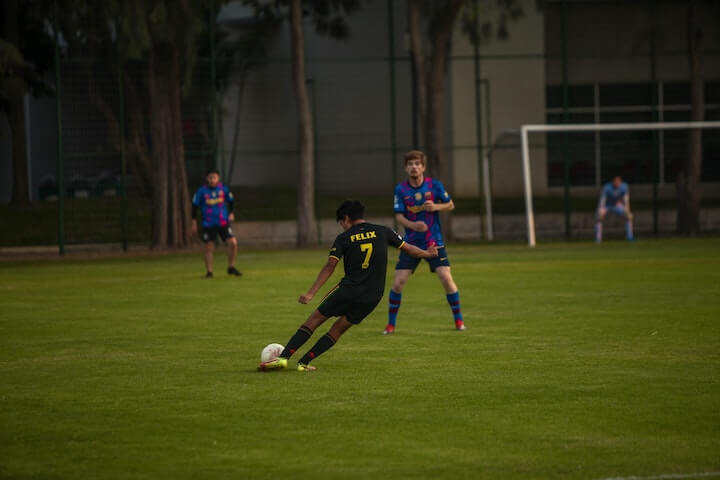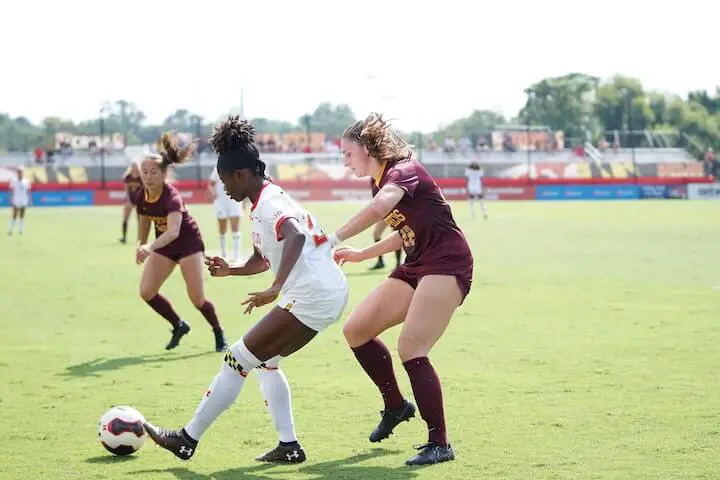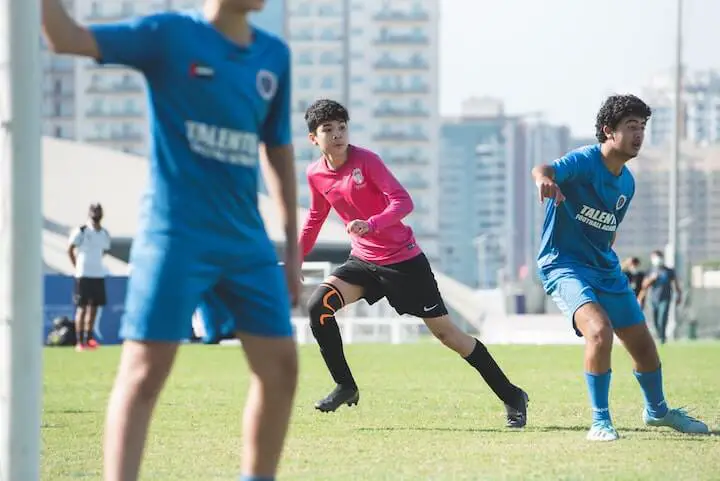What Position is the Number 7 in Soccer? (Role Explanation)
The number 7 in soccer is one of the most sought-after and respected shirts a player can wear.
It has a long-standing association with soccer’s greats through multiple generations.
From two-time World Cup-winning (1958 and 1962) Brazilian icon, Garrincha, all the way through to Cristiano Ronaldo or Kylian Mbappe today.
In modern soccer, numbers don’t necessarily indicate a player’s position.
That said, some are symbolic and reserved especially for those worthy of the honor.
While coveted numbers can vary between clubs, the number 7 holds esteem in every side, especially among wingers and attackers.
But why is the number 7 in soccer so special?
In this article, we take a look at the history of the number, then break down the role, skill set, and famous players who’ve worn the shirt.
Brief History of the Number 7
Traditionally, squad numbers from 1 to 11 have direct links to different positions.
This dates all the way back to the early 1900s when they were first introduced.
Although formations and positions were vastly different back then, squad numbers have adapted as the game evolved.
Throughout history, right midfielders or advanced attackers wore the number 7.
Since most teams played their best attackers in these types of positions, the number 7 quickly became associated with flair, skill, pace, and goal contributions.
Similarly, the number 9 and number 10 were mainly worn by strikers who were key goalscorers.
In the early 1990s, many global soccer leagues introduced a rule that required teams to register players with a specific squad number which they would keep for the entire system.
Teams no longer handed out the numbers 1 to 11 to the starters.

Roles of a Number 7 in Soccer
Any play can wear the number 7... in theory.
But more often than not, it’s reserved for wingers or occasionally, strikers.
So, for the purpose of this article, we’re going to focus on the wide players.
Historically, right midfielders were right-footed, while left midfielders were left-footed, meaning they predominantly attacked down the line and swung in crosses from the wings.
In the modern game, however, most teams play with inverted wingers.
This means wide players positioned themselves on their weaker side, looking to cut in toward the center of the goal to shoot, make intricate passes, or open alternative crossing angles.
Regardless of a winger’s particular style of play, the role of a number 7 are usually the same.
Role #1 - Beating Opponents 1v1
Wingers are creative flair players that use their skill, pace, and technique to create chances for themselves or others.
One of the most important roles of a winger is to beat their opponent off the dribble.
A good 1v1 dribbler forces defenders to commit. This forces the backline to shift, which allows other players to find room to receive the ball and get a shot on goal.
Since many wingers today play the inverted role, they’re dangerous when attacking down the line and through the center.
Players like Arjen Robben and Gareth Bale could use their pace to go down the outside and whip in a cross or cut inside for a quick one-two.
Today, many of the top scorers in major soccer competitions are wide attackers who can use their footwork and pace to create their own chances.
Role #2 - Goalscoring
As with most other attacking players, wingers get judged based on their output.
Many modern teams have now veered away from a traditional 4-4-2 formation and set out with a front three that consists of two wingers and a single striker.
With just one out-and-out goalscorer in the team, there is much more reliance on wingers to contribute goals.
This deviation from the two-striker system has also contributed to the trend of inverted wingers.
By playing on their weaker side, wingers are far more dangerous when cutting in and attacking the goal directly.
Some of the best examples of goalscoring wingers in the modern game include Mo Salah, Sadio Mané, and Kylian Mbappe (who happens to wear the number 7).
Role #3 - Creating Goalscoring Chances
In addition to scoring, assists are a winger's bread and butter.
One of the most iconic number 7s in soccer, David Beckham, was one of the sweetest strikers of the ball the game has ever seen. He would deliver pinpoint crosses from central or wide areas, leaving strikers with the simple task of poking the ball home.
There has been a big focus on “goal contributions” among attacking players recently.
While it can get frustrating for fans to watch wingers, they can view them as successful as long as they consistently score and assist. After all, professional-level games are decided by extremely thin margins.
Attacking players must be brave and take risks to find a path to goal.
Role #4 - Stretching the Field
If you’ve read any of our other position breakdowns, you’ll know how much we value good positional sense in soccer.
It’s one of the most important attributes of any top player -- and wingers are no different.
When it comes to positioning, a winger’s primary role is to stretch the field.
This requires discipline and patience.
Many players get the itch to drift infield if they’re struggling to get a touch.
But this makes it easier for defenders to tighten up and block passing lanes.
Wingers get the majority of their success by exploiting the available space.
This increases gaps in the opposition's midfield and defense for other attackers to run into.
Role #5 - Launching Counterattacks
Counterattacking is a popular and effective strategy that many teams rely on - especially those with speedy attackers.
When defending set pieces, wingers must position themselves to break quickly if the ball comes their way.
While many counterattacks might seem like they’re off the cuff, they usually aren’t.
Starting positions and off-the-ball movements for each player are typically drawn up by the coach and practiced regularly.
For example, when defending corner kicks, the defending team usually leaves one or two of their quickest players outside of the penalty area. This gives them the chance to sprint if the opportunity arises.
Role #6 - Tracking Back
Although a winger’s primary job is to attack, score, and assist...
They must not abandon their defensive duties.
Off the ball, wide players must track back, help out their fullbacks, and mark other attackers that make overlapping runs. Otherwise, they leave the defense vulnerable to overloads that can easily lead to chances for the opposition.
In modern soccer, teams defend and press in groups so it’s critical that all players work in tandem when they’re trying to regain possession.
Role #7 - Taking Set Pieces
The skill set of a wide player means they are often the best strikers of the ball on their teams.
In addition, many wingers are relatively small in stature, utilizing their low center of gravity and nimble frame to zip past defenders at speed.
Therefore, they may not be of much use inside the penalty box on an in-swinging cross.
That's why many wingers are responsible for taking set pieces for their teams, including corner kicks, free kicks, and penalties.

Key Skills of a Number 7
Attacking players have varied skill sets -- with body type, physical characteristics, and technical abilities having enormous impacts on playing style.
Only a select few wingers, like Cristiano Ronaldo (earlier in his career), could be described as having all the desired skills to succeed as a winger.
That said, below are some of the key skills that top wingers possess.
Great players possess at least four or five of these key attributes.
Skill #1 - Striking Technique
David Beckham, Ronaldinho, Leo Messi, Cristiano Ronaldo, Mo Salah, Riyad Mahrez...
Each of these players has dominated the wings and used their exceptional striking technique to provide moments of brilliance on the biggest stages.
Skilled attackers have the ability to punish their opponents when given an opportunity.
Having elite striking technique is essentially an ace in the pocket that can turn a game on its head in a split second, whether it’s a perfectly timed cross or a sweet strike from 30 yards.
Skill #2 - Dribbling
Without high-level dribbling skills, wingers will struggle to beat an opponent 1v1.
Very few attackers make it to the highest level without having the footwork and skill moves necessary to get past a defender.
Although some wingers, like Arjen Robben or Eden Hazard, play with instinct and natural skill, the ability to beat a player off the dribble comes from hours of practice.
Footwork drills, cone weaves, and 1v1 drills are absolutely essential for up-and-coming wingers to hone their skills.
Skill #3 - First Touch
An excellent first touch can be key in big moments, especially in the attacking third.
It can buy you an extra second, set you up for a quick shot, or leave the defender for dead.
While players in the backline can sometimes get away with having a less-than-perfect first touch, the same can’t be said for attackers.
When time and space are minimal, a good first touch is essential.
Skill #4 - Pace
Pace isn’t an absolute must for all number 7's.
In fact, some wingers like Jadon Sancho, aren’t necessarily blessed with natural speed but have the technical skills needed to beat the fullback and ghost defenders.
That said, acceleration and pace are major advantages for attackers.
In soccer, speed kills.
Skill #5 - Stamina
Wingers frequently cover a staggering 6 miles throughout a 90-minute game.
Moreover, the nature of this position means that this distance involves a lot of sprints.
To meet the physical demands of playing on the wing, the position requires elite stamina.
With so many games decided in the dying minutes, it’s a massive benefit to have one of the fittest attackers on the field in your team.
When defenders begin to tire, a super-fit winger can exploit fatigue and weaknesses that lead to goalscoring opportunities.
Skill #6 - Vision
As some of the most important creators on the pitch, number 7's must have excellent vision to thread a through ball or find their striker’s head in the box.
A winger can have all the tricks in the book, but without an end product, they don’t add enough value to their team.
The ability to spot a run or see a key pass is something that comes naturally to some.
However, players can develop this skill by studying patterns of play and getting into the habit of dribbling with your head up and scanning the field.
These habits can be the difference between 10 or 25+ goal contributions in a season.

Famous Players Who Wore Number 7:
As one of the most famed and popularized shirts in the game, there is a long list of icons who have donned the number 7 in soccer.
Here are some attackers that you might have heard of:
- Cristiano Ronaldo
- Franck Ribery
- Kylian Mbappe
- David Beckham
- George Best
- Eric Cantona
- Luis Figo
- Garrincha
- Robert Pires
- Raúl González
- Kevin Keegan
- Bastian Schweinsteiger
Conclusion
There you have it, the legend of the number 7 in soccer.
With each generation, we see a new star arise, brandishing the iconic digit on their back.
From the long list of soccer heroes wearing the shirt, it’s no surprise that it’s still the envy of some of the biggest talents in the game.

